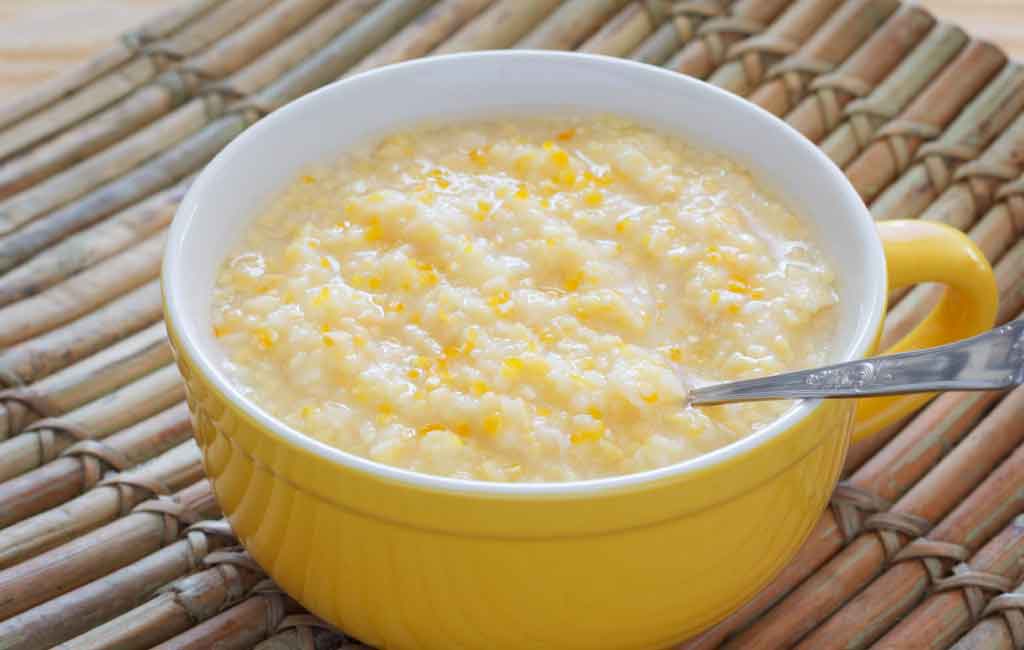Have you ever wandered the aisles of a grocery store looking for polenta and coming up empty-handed? If so, you’re not alone. Polenta can be a bit elusive for those unfamiliar with this tasty dish. In this article, we will help you navigate the grocery store to find polenta, making your shopping experience easier and quicker.
First, let’s briefly discuss what polenta is. Polenta is a versatile dish made from coarsely-ground cornmeal that can be boiled or fried and served as a side or main course. It has a delicious texture and flavor, making it a popular choice for many home cooks. Now that we’ve covered the basics, let’s dive into where you can locate polenta in your local grocery store.
Typically, there are two primary places where you might find polenta in a grocery store. If you’re looking for the pre-cooked version, check the refrigerated produce section, usually near tofu or other meat alternatives. For the dry polenta, head to the dry goods and pasta aisle, where you may come across brands like Bob’s Red Mill, DeLallo, and Ancient Harvest. Some grocery stores, like Kroger, Publix, Wegmans, and Albertsons, are known to carry a variety of polenta brands.
Polenta in the Grocery Store
Aisle Locations
When looking for polenta in the grocery store, you may find it in different aisle locations depending on the store. Here are some common aisle locations:
- Pasta aisle: In many stores, such as Safeway, Kroger, and your local grocery store, polenta can be found near the pasta section.
- International aisle: Some stores, like Whole Foods and Italian markets, might stock polenta in the international or Italian section.
- Dry goods section: Stores like Publix may place polenta in the dry goods section.
In addition to these aisles, some stores carry precooked polenta, which is often stocked in a different location from the instant variety:
- Refrigerated produce section: Precooked polenta tubes are usually found in the refrigerated produce section, possibly near the tofu.
Store Guide
To help you find polenta more easily in popular grocery store chains, here’s a quick store guide:
- Safeway: You’ll likely find polenta with the pasta or in the international aisle.
- Kroger: Kroger stores often carry brands like Bob’s Red Mill, DeLallo, Ancient Harvest, and Bellino. Instant polenta is usually found in the dry goods or pasta aisle.
- Whole Foods: Look for polenta in the international aisle, specifically the Italian section.
- Italian markets: Italian American specialty stores or Italian markets typically stock polenta with other Italian products.
- Publix: You might find brands like San Gennaro and Ancient Harvest in the dry goods or pasta aisle.
- Wegmans: Polenta can be found near the pasta or in the Italian section.
- Albertsons/Ralphs/Fred Meyer: Check either the pasta aisle or the international aisle for polenta.
Remember to check for both instant polenta and pre-cooked polenta in different sections of the store, as they might not always be placed together. Be sure to consult the store’s aisle directory or ask a store associate for help if you’re having trouble locating the polenta.
Finding Polenta Online
Finding polenta online is quite easy and convenient, making it a great option for those who prefer shopping from the comfort of their home. Two popular online retailers where you can purchase polenta are Amazon and Walmart.
Amazon offers a variety of polenta options, including instant polenta and tubed polenta. Their wide selection allows you to choose from different brands and types, depending on your preference. You can access Amazon’s website or use their mobile app to browse and purchase the polenta of your choice. Ensure to check the product description and customer reviews to make an informed decision.
Similarly, Walmart also sells polenta in their online store. They carry various brands, ensuring that you have a diverse selection to choose from. To find polenta on Walmart’s website, simply search for “polenta” in the search bar, and you will be presented with a list of available products.
Remember, when shopping online, always consider the shipping fees and delivery times, as these can vary depending on your location and the seller. Additionally, keep an eye out for any sales or deals that the retailers may offer to save on your purchase.
What Is Polenta
Polenta is a traditional Italian dish made from coarsely-ground cornmeal. It originated in northern Italy and has been a staple in the region for centuries. The primary ingredient in polenta is flint corn, a type of corn that has a hard outer layer and a soft interior, making it perfect for grinding into cornmeal.
There are two main types of cornmeal used to make polenta: white cornmeal and yellow cornmeal. White cornmeal is made from dent corn, which has a softer texture and a milder flavor than flint corn. Yellow cornmeal is made from flint corn and has a more robust flavor and a slightly coarser texture. Both types of cornmeal can be used interchangeably to make polenta, depending on your personal preference and desired flavor.
To make polenta, you’ll need a ratio of approximately four or five parts water to one part cornmeal. Boil the water, then slowly add in the cornmeal while continuously stirring to avoid clumping. The polenta will begin to thicken as it cooks. Cooking time can vary depending on the type of cornmeal used and the desired consistency, ranging from 20 to 40 minutes for regular polenta and just a few minutes for instant or quick-cooking polenta.
When shopping for polenta in a grocery store, you can find it in various forms:
- Packaged polenta or ground cornmeal: Typically found in the baking aisle, these packages of dry cornmeal allow you to make polenta from scratch. Simply follow the cooking instructions and add your own seasonings or ingredients to customize the dish.
- Pre-made tubes of cooked polenta: Convenient and ready-to-use, these tubes can be found in the refrigerated produce section of your grocery store. They can be sliced, grilled, fried, or baked and are a great option for quick meals.
Remember, when searching for polenta in your local grocery store, you can choose between white or yellow cornmeal depending on your preference. Don’t be afraid to experiment and find the perfect polenta recipe for you and your family.
Types of Polenta
When you’re at the grocery store looking for polenta, you’ll come across different types available for your cooking needs. Here are the main types of polenta you might encounter:
Dry Polenta
Dry polenta is simply ground cornmeal, commonly found in boxes or bags in the baking aisle. It comes in two main forms: coarse ground polenta and fine ground polenta. Coarse ground polenta has a more substantial texture, while fine ground polenta is smoother. Both can be cooked with a ratio of four- or five-to-one water to cornmeal. They’re a versatile option for creating a variety of dishes, from a creamy porridge to crispy cakes.
Instant Polenta
Instant polenta, also known as quick-cooking polenta, has been partially cooked and dried, enabling you to prepare it more quickly. Typically found in the dry goods and pasta aisle, instant polenta is a great time-saving option when you’re looking to whip up a dish with minimal effort.
Tubes of Polenta
Pre-cooked tubes of polenta can be found in the refrigerated produce section or near the pasta and dried food section. They’re a convenient choice for slicing and grilling, sautéing, or baking. Simply slice the tube into rounds and incorporate them into your dishes with meat, vegetables, or cheese.
When preparing your polenta dishes, feel free to get creative with flavors. Parmesan cheese, for example, can be stirred into cooked polenta for a richer, creamier taste. You can also add herbs and spices to suit your preferences.
Keep in mind, most polenta is inherently gluten-free, making it suitable for those with gluten sensitivities or allergies. However, it’s essential to carefully read the packaging labels to ensure no gluten-containing ingredients have been added.
In summary, you can find various types of polenta in the grocery store, including dry polenta, instant polenta, and pre-cooked tubes. Each type is suitable for different purposes, and all can be combined with a range of ingredients such as cheese, meat, vegetables, or herbs and spices. So, feel free to experiment in your cooking and enjoy the versatility that polenta has to offer.
Cooking and Serving Polenta
Polenta Dishes
Polenta, a versatile dish made from coarsely-ground cornmeal, can be served in numerous ways, such as polenta fries, cakes or bread. Transform the creamy base into a delicious snack or meal accompaniment by pairing it with savory ingredients like cheese and herbs or sweet toppings like maple syrup.
Instant Polenta vs Traditional Polenta
While you can find traditional polenta in the Italian section or in the pasta aisle of your grocery store, you may also come across instant polenta, which significantly reduces the cooking time. Traditional polenta needs to be cooked for 30 minutes over low heat, while Instant polenta only takes about 5 minutes. To make traditional polenta:
- Bring 5 cups of water and 1 teaspoon of salt to a boil in a large saucepan.
- Pour 1 cup of coarse-ground cornmeal slowly into the boiling water, whisking constantly to prevent lumps.
- Reduce heat to low, and continue whisking until the polenta starts to thicken (around 5 minutes).
- Cover and cook for 30 minutes, whisking every 5 to 6 minutes.
Storing Polenta
When storing uncooked polenta, put it in an airtight container and place it in a cool, dry place. However, once cooked, transfer the leftover polenta to an airtight container and store it in your refrigerator for up to one week. You can also freeze polenta in individual portions to make future meal preparation easier.
If using an Instant Pot to cook polenta, refer to the device’s user manual for detailed instructions and the appropriate cooking times based on the amount and variety of cornmeal you’re using.
The price of polenta varies depending on the brand and type (instant or traditional) you choose, so be sure to compare prices in your local grocery store to find the one that fits your budget and culinary preference.
Polenta Recipes and Pairings
When you’re exploring delicious ways to enjoy polenta, it’s helpful to know what types of dishes and pairings work well with this versatile ingredient. Here are some ideas for creating tasty polenta-based meals:
- Saucy Dishes: Polenta serves as an excellent base for sauces, stews, and thick soups. Some examples include Chicken and Roast Veggie Stew over Polenta, Polenta with Kale, Beans and Sausage, and Kale, Mushroom and Tomato Sauté with Polenta. These recipes showcase how the thick and creamy texture of polenta complements various ingredients and flavors.
- Dipping Sauce: Polenta fries or wedges make a delightful snack or appetizer, particularly when paired with a flavorful dipping sauce. Try serving polenta fries with a homemade marinara sauce, a zesty aioli, or a bold and spicy harissa sauce to elevate your dish to the next level.
- Toppings and additions: Polenta is versatile and easily adaptable to your favorite flavors. Consider mixing in cheese, herbs, and other seasonings. For example, you could top your polenta with grated Parmesan cheese and heat it under the broiler for a few minutes before serving. Alternatively, you can mix herbs and spices into the polenta before cooking to infuse it with flavor.
- Recipes using tubed polenta: Pre-cooked polenta in a tube is a convenient alternative to traditional polenta, and it can be sliced and used in various recipes. Consider trying dishes like Cuke-a-Mato Broiled Polenta or Polenta Caprese Bites, which involve sliced tubed polenta that retains its shape for easy assembly.
Remember to experiment with different flavor combinations and techniques to make the most of your polenta dishes and enjoy this versatile ingredient.

